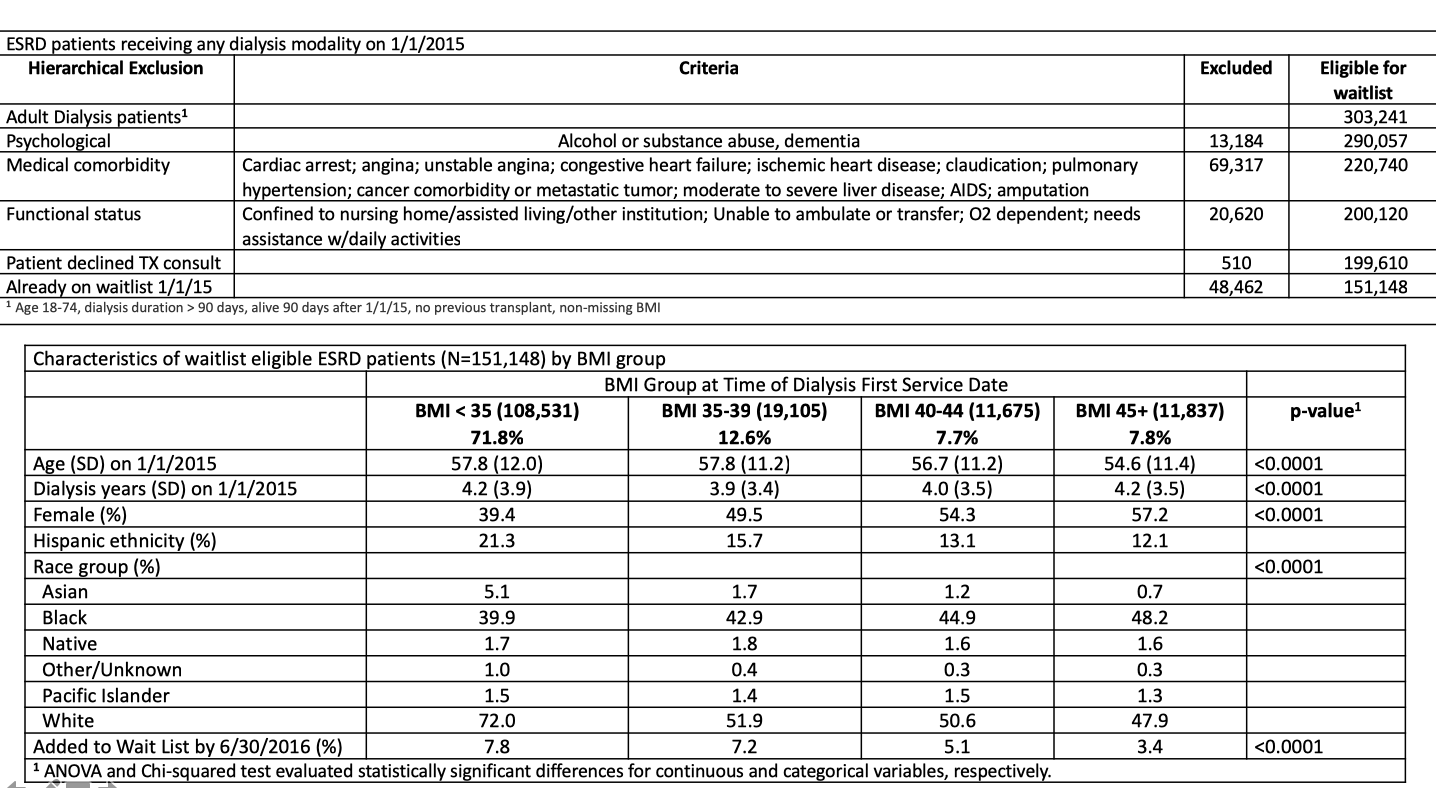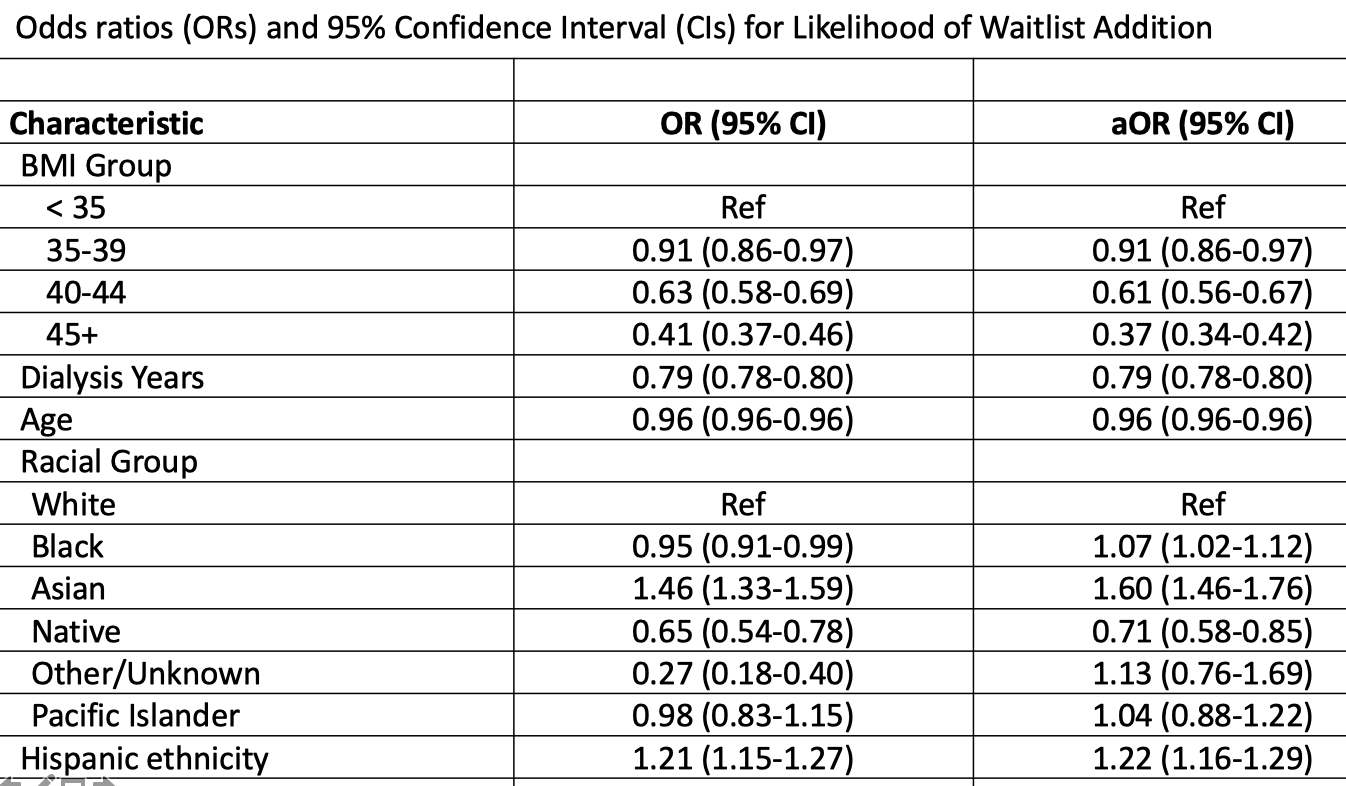Quantifying the Number of ESRD Patients Who Might Benefit from Bariatric Surgery to Achieve Listing for Transplant
B. Orandi1, P. MacLennan1, S. Mehta1, J. Grams1, R. Stahl1, R. Cannon1, D. Anderson1, M. Hanaway1, C. Young1, J. Purvis1, N. Terrault2, C. Lewis1, J. Locke1
1University of Alabama at Birmingham, Birmingham, AL, 2University of Southern California, Los Angeles, CA
Meeting: 2020 American Transplant Congress
Abstract number: 129
Keywords: Kidney, Kidney transplantation, Obesity, Waiting lists
Session Information
Session Name: Kidney: Cardiovascular and Metabolic Complications I
Session Type: Oral Abstract Session
Date: Saturday, May 30, 2020
Session Time: 3:15pm-4:45pm
 Presentation Time: 4:15pm-4:27pm
Presentation Time: 4:15pm-4:27pm
Location: Virtual
*Purpose: Mounting evidence suggests bariatric surgery may play a role in helping obese ESRD patients achieve sufficient weight loss to be transplant-eligible. We sought to quantify the number of ESRD patients who are precluded from transplant by BMI alone and might therefore benefit from aggressive weight loss intervention.
*Methods: We used 2017 US Renal Data System data to identify all patients undergoing dialysis for at least 90-days on 1/1/2015. We excluded those with missing BMI, patients who died within 90 days of 1/1/2015, and previous transplant recipients.To classify BMI, and determine transplant eligibility we reviewed Medical Evidence file (CMS 2728 form) and 2014 claims data. We considered non-waitlisted dialysis patients without contraindications for transplantation other than excess BMI to be eligible. After exclusions, we examined the probability of wait list addition, through June 2016, with univariate and multivariable logistic regression and assessed significant interactions with the inclusion of a product term of BMI group and other covariates.
*Results: After exclusions, there were 151,108 unlisted ESRD patients without other transplant contraindications, with 28.2% having a high BMI (BMI>=35; 108,531, 19,105, 11,675, and 11,837 in the BMI<35, 35-39, 40-44, and 45+ groups). Higher BMI patients were more likely to be female (P<0.001) and black (P<0.001). Relative to ESRD patients with BMI< 35, there was a monotonic decrease in likelihood of waitlist addition by BMI group. Those in the BMI 45+ group had a 63% lower likelihood of listing (aOR=0.37; 95%CI 0.34-0.42). No significant interactions between BMI group and other model covariates were found.
*Conclusions: 28.2% of unlisted, otherwise-transplantable ESRD patients have BMI>=35, rendering them significantly less likely to achieve listing. Aggressive weight loss intervention may help them achieve the benefits of kidney transplantation.
To cite this abstract in AMA style:
Orandi B, MacLennan P, Mehta S, Grams J, Stahl R, Cannon R, Anderson D, Hanaway M, Young C, Purvis J, Terrault N, Lewis C, Locke J. Quantifying the Number of ESRD Patients Who Might Benefit from Bariatric Surgery to Achieve Listing for Transplant [abstract]. Am J Transplant. 2020; 20 (suppl 3). https://atcmeetingabstracts.com/abstract/quantifying-the-number-of-esrd-patients-who-might-benefit-from-bariatric-surgery-to-achieve-listing-for-transplant/. Accessed December 23, 2025.« Back to 2020 American Transplant Congress


